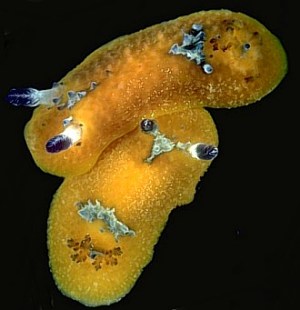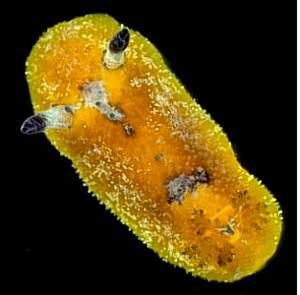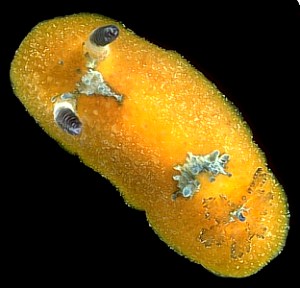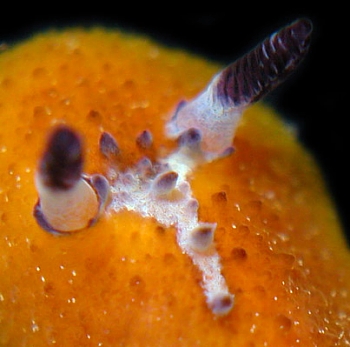
Siraius immonda
(Risbec, 1928)
Order: NUDIBRANCHIA
Suborder: DORIDINA
Superfamily: EUDORIDOIDEA
Family: Dorididae
DISTRIBUTION
Previously known only from Western Pacific, but reported here [message #21906 ] from the Red Sea.
PHOTO
Upper & Lower right: Solitary Ids., Coffs Hbr region, NSW, 3 Nov 1990. C164157. Lower left: Pointe de Pandop, Koumac, New Caledonia, 20°35.2'S, 164°16.6'E, 2m, Hard substrate 18 October 1993, 11mm long alive. Photos: Bill Rudman.
Risbec (1928) described a yellow orange dorid with purplish elongate rhinophores and a tuberculated inverted Y pattern on its dorsum. It had an orange egg mass. His description and an examination of the type specimen in the Paris Museum show that this species is the same as the species exhaustively described (Brodie & Willan, 1993) from Queensland and Norfolk Island as Siraius nucleola (Pease). I have posted a copy of Risbec's painting below. It is characterised by a firm ovate tuberculate mantle, usually a dull yellow brown but sometimes darker, with an hourglass pattern between the gills and the rhinophores. Theis pattern may be broken into an anterior and posterior patch. The underside is orange-yellow.
I cannot agree with Brodie & Willan's synonymy of Platydoris immonda Risbec with Doris nucleola Pease, Doriorbis nucleola Kay & Young, or Doris carinata Alder & Hancock. In Pease's description of D.nucleola no mention is made of any dorsal markings between the gills and rhinophores, and none are illustrated in Garret's illustration (Bergh, 1881). To confuse things more, it is unlikely that the animal Kay & Young, (1969) identified as Doriorbis nucleola (Pease), with a prominent T or Y shaped pattern between the gills and rhinophores, is either Pease's species or Risbec's.
Brodie & Willan also consider Doris carinata Alder & Hancock (1864) to be a synonym. The shape of the median dorsal patch is similar but the high body profile are quite different from S. immonda. Also, the description of the gills as `numerous .. forming a complete circle' differs markedly from the 5 gills in S. immonda. While many of Alder & Hancock's species are easily identified, there are others which will remain problematic. Subsequent to Brodie & Willan, Baba (1993) identified a Japanese species with Siraius nucleola sensu Brodie & Willan.
It does not seem possible to clarify the identity of all the old names. There are many nodulose dorids with an elongate colour patch between the gills and the rhinophores. The species described by Brodie & Willan from eastern Australia and Norfolk Island, and Baba from Japan, is clearly identical to Risbec's Platydoris immonda. Until further material of Hawaiian and Indian specimens are available, further attempts at matching names from those regions with species from the southwestern Pacific will be unrewarding. I have followed Brodie & Willan in placing this species in the genus Siraius.
References:
•Baba, K (1993) A new record of Siraius nucleola (Pease, 1860) (Nudibranchia: Dorididae) from Japan. Venus, The Japanese Journal of Malacology 52(4): 291-297.
•Bergh, L.S.R. (1881) Nachtrage. Malacologische Untersuchungen. In: C.G. Semper, Reisen im Archipel der Philippinen, Wissenschaftliche Resultate. Band 2, Supplement 2.: 79-128, Pls.G, H, J-L.
• Brodie, G.D. & Willan, R.C (1993) Redescription and taxonomic reappraisal of the tropical Indo-Pacific nudibranch Siraius nucleola (Pease, 1860) (Anthobranchia: Doridoidea: Dorididae). The Veliger 36(2): 124-133.
•Kay, E.A. & Young, D.K. (1969) The Doridacea (Opisthobranchia: Mollusca) of the Hawaiian Islands. Pacific Science 23(2): 172-231.
•Pease, W.H. (1860) Descriptions of new species of Mollusca from the Sandwich Islands.
Proceedings of the Zoological Society of London 28: 18-36.
•Risbec, J. (1928) Contribution a l'etude des nudibranches Neo-Caledoniens. Faune des Colonies Francaises 2(1): 1-328, Pls.1-12.


Rudman, W.B., 2000 (April 14) Siraius immonda (Risbec, 1928). [In] Sea Slug Forum. Australian Museum, Sydney. Available from http://www.seaslugforum.net/find/siraimmo
Related messages
Siraius immonda? from the Red Sea
September 23, 2008
From: Erwin Koehler

Concerning message #19953:
Dear Bill,
Here are 2 shots which think they show Siraius immonda, I scanned many hours through the webites and my books to get this ID, I hope you can confirm.
Locality: Hurghada, El Fanadir Foc, 9 m, Egypt, Red Sea, 18 April 2007, upon rocks. Length: 12 mm. Photographer: Sven Kahlbrock.
I don't know, if this is the first record of it from the Red Sea/ Indian Ocean
Cheers
Erwin
Erwin@Philippine-Sea-Slugs.com
Koehler, E., 2008 (Sep 23) Siraius immonda? from the Red Sea. [Message in] Sea Slug Forum. Australian Museum, Sydney. Available from http://www.seaslugforum.net/find/21906
Dear Erwin,
It certainly looks like Siraius immonda to me. On the Fact Sheet, which I have just altered, I said didn't know of any Indian Ocean records of this species, so this is indeed a valuable addition to our knowledge. Recent studies have proposed that Siraius (and many other genera)are synomyms of Doris. This may prove correct but there are still a lot of 'loose ends' to be sorted out. For example the type species of Siraius needs to be re-examined.
Best wishes,
Bill Rudman
Re: Siraius immonda from sthn Queensland [2]
May 26, 2007
From: Bruce Wilkie

Concerning message #19930:
Hi Bill,
Here is another Siraius immonda for the Forum.
I found this one on the same day that Gary's original message was posted.
Locality: Flat rock, Point lookout, Nth Stradbroke island, 9 metres, Queensland, Australia. , Pacific ocean., 21 May 2007, Rocky reef, hard and soft corals, sponger. Length: 25 mm. Photographer: Bruce Wilkie.
Many thanks,
Bruce Wilkie.
brucedwilkie@yahoo.com
Wilkie, B, 2007 (May 26) Re: Siraius immonda from sthn Queensland [2]. [Message in] Sea Slug Forum. Australian Museum, Sydney. Available from http://www.seaslugforum.net/find/19953
Dear Bruce,
I haven't seen such a red specimen before. As soon as I saw your photo it reminded me of Halgerda rubicunda Baba 1949, which has long puzzled me as it does not appear to be a species of Halgerda. In Baba's original description he published two paintings, one with Halgerda-like ridges and the other with tubercles [see image alongside Pl. 25, figs 94-5]. He describes the mantle as having 'finely reticulate ridges with distinct knobs at the points'.
Although there are appear to be some differences in the denticulation of the outer radular teeth, I wouldn't be at all surprised if Halgerda rubicunda turns out to be another synonym of Siraius immonda.
-
Baba, K (1949) Opisthobranchia of Sagami Bay collected by His Majesty The Emperor of Japan. Iwanami Shoyen, Tokyo. 194pp
Best wishes,
Bill Rudman
Re: Siraius immonda from sthn Queensland
May 25, 2007
From: Gary Cobb

Concerning message #19925:
Hi Bill
Attached is another photo of a green version of Siraius found intertidally at Alexandra Headland. 2 other green ones were found too.
Locality: Alexandra Headland, .02 m, Queensland, Pacific Ocean, 19 May 2007, Intertidal. Length: 10 mm. Photographer: Gary Cobb
Gary
gary@nudibranch.com.au
Cobb, G.C., 2007 (May 25) Re: Siraius immonda from sthn Queensland. [Message in] Sea Slug Forum. Australian Museum, Sydney. Available from http://www.seaslugforum.net/find/19930
Dear Gary,
Thanks for this nice green animal - I have included alongside a copy of Risbec's painting [Pl. 1 fig. 4] of Platydoris immonda to show how similar they are.
-
Risbec, J. (1928) Contribution a l'etude des nudibranches Neo-Caledoniens. Faune des Colonies Francaises 2(1): 1-328, Pls.1-12.
Best wishes,
Bill Rudman
Siraius immonda from sthn Queensland
May 21, 2007
From: Gary Cobb


Concerning message #2276:
Hope the holiday was good...when are messages going to able to be sent again? I would like to send to you a nice one...Siraius 14 mm long found at 16m depth under overhang off Mooloolaba. Thanks Bill!
Cheers,
Gary
gary@nudibranch.com.au
Cobb, G., 2007 (May 21) Siraius immonda from sthn Queensland. [Message in] Sea Slug Forum. Australian Museum, Sydney. Available from http://www.seaslugforum.net/find/19925
Dear Gary,
My holiday seems a long time ago now. Since returning I have had to spend time on finishing a scientific, edit some other people's papers, go through the backlog of emails etc that built up while I was away and start to go through the unanswered messages to the Forum which have been building up since Christmas. I have decided to keep on with answering those for a couple more weeks before opening the floodgates for more messages. If anyone has an urgent, or particularly exciting message, or wishes to reply to an existing message you can still post messages through the reply button on every page.
Now to your Siraius message. Thanks for these nice photos. Angel Valdes (2002) in his survey of the cryptobranch dorids decided to synonymise about 10 genera including Siraius and Doriorbis which have been used for this species, into the old genus Doris. This study has certainly given us food for thought but I think it is too early to accept all the synonymies without further consideration. One methodological practice I have difficulty with is the use only of type species of genera. If you just compare one species of each genus then 2 or 3 small anatomical differences may seem insignificant, but if there are 5 or 10 species all with the same differences then surely the fact that there are groups of species with the same small differences becomes significant in itself - and in a cladogram would add a further level of branching? That after all is what genera are supposed to be - groups of species with the same differences. If you only use type species then you are deliberately avoiding the possibility of groups.
- Valdés, A. (2002) A phylogenetic analysis and systematic revision of the cryptobranch dorids (Mollusca, Nudibranchia, Anthobranchia). Zoological Journal of the Linnean Society 136: 535-636.
Best wishes,
Bill Rudman
Siraius immonda from Japan
April 18, 2000
From: Yasuhiro Shirai

Dear Bill,
This animal's body color and gills are orange. Could you please identify this animal for me.
Data:
Location: Kushimoto Japan
Length: 25mm
Water temperature: 15C
Date 11 March 2000
Depth: -3m
Crawling on rock.
Best regards,
Yasuhiro Shirai
yasuhiro@e-net.or.jp
Shirai, Y., 2000 (Apr 18) Siraius immonda from Japan. [Message in] Sea Slug Forum. Australian Museum, Sydney. Available from http://www.seaslugforum.net/find/2276
Dear Yasuhiro,
I identify this animal as Siraius immonda Risbec. It is the same animal that has recently been identified as Siraius nucleola. Specimens from Australia (Willan & Brodie, 1993) are usually a yellow or orange colour, but Baba has reported animals from Japan which range in colour from yellow to blue green. (see References at Top of Page).
I have included [far right] a copy of Risbec's illustration (1928: Plate 1, fig 4) of a species he named Platydoris immonda from New Caledonia, which is clearly the same species. I have put a photo of an animal from New Caledonia at the Top of the Page. The name suggested by Willan & Brodie (1993) and used by Baba (1993), is based on a species described by Pease (1860) from Hawaii, Doris nucleola, the description of which was not illustrated, and makes no mention of the characteristic markings in the dorsal midline. The paintings [Fig 10, 11 on right] are Andrew Garrett's, subsequently published by Bergh (1881: Plate G), of the animal described by Pease.
I think the earliest recognisable name for this species is Platydoris immonda Risbec, 1928. I have followed earlier authors in placing it in the genus Siraius but am not sure whether an exhaustive review of the dorid genera would agree with that decision.
Best wishes,
Bill Rudman.
